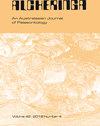An overview of ichthyosaurian remains from the Cretaceous of Texas, USA
IF 1.5
4区 地球科学
Q3 PALEONTOLOGY
引用次数: 2
Abstract
The clade nominal Ophthalmosauridae encompasses all currently recognized ichthyosaurian taxa from the mid-Cretaceous (Albian–Cenomanian) time interval in North America. These would have inhabited what is today known as the Western Interior Seaway. The remains represent mid to large-sized (up to around 5 m in maximum body length) ichthyosaurians that are mainly based upon isolated teeth and vertebrae, although some partial skeletons have been recovered from both the USA and Canada. Most of these fossils have taxonomic affinities with platypterygiines, such as the ubiquitous ‘form genus’ Platypterygius. This taxon has historically been the default identification for most North American Cretaceous ichthyosaur specimens. However, in comparison with remains from elsewhere, the ichthyosaurian fossils from Texas have been relatively understudied. Here, I review the existing records and present a concise list of all Cretaceous ichthyosaurian material currently held in public museum collections across the state. I have recognized 11 Cretaceous ichthyosaurian occurrences from Texas, including an indeterminate tooth, numerous vertebral centra, and some fragmentary skeletal remains attributable to Platypterygius. Ichthyosaurians therefore demonstrably occupied the Cretaceous epeiric seas of Texas from at least the Albian to middle Cenomanian, a distribution that traverses both the western and eastern coastlines of the Western Interior Seaway during its early phase of southern epicontinental incursion.美国德克萨斯州白垩纪鱼龙化石概述
眼龙科进化枝包括了北美洲白垩纪中期(Albian-Cenomanian)时期已知的所有鱼龙类群。他们可能居住在今天被称为西部内陆海道的地方。这些遗骸代表了中型到大型(最大体长约5米)的鱼龙,主要是基于孤立的牙齿和椎骨,尽管在美国和加拿大都发现了一些部分骨骼。这些化石中的大多数在分类上与鸭嘴兽有亲缘关系,比如无处不在的“形式属”鸭嘴兽。这个分类群在历史上一直是大多数北美白垩纪鱼龙标本的默认识别。然而,与其他地方的化石相比,德克萨斯州的鱼龙化石研究相对不足。在这里,我回顾了现有的记录,并提供了一份简明的清单,列出了目前在全州公共博物馆收藏的所有白垩纪鱼龙材料。我在德克萨斯州发现了11种白垩纪鱼龙,包括一颗不确定的牙齿,许多椎体中心,以及一些属于鸭嘴兽的碎片骨骼残骸。因此,鱼龙类至少从阿尔比尼亚到塞诺曼尼亚中期占据了德克萨斯州的白垩纪表海,在南部表陆入侵的早期阶段,这一分布横跨了西部内陆海道的东西海岸线。
本文章由计算机程序翻译,如有差异,请以英文原文为准。
求助全文
约1分钟内获得全文
求助全文
来源期刊

Alcheringa
地学-古生物学
CiteScore
2.60
自引率
7.70%
发文量
28
审稿时长
>12 weeks
期刊介绍:
Alcheringa : An Australasian Journal of Palaeontology is the official journal of the Australasian Palaeontologists.
Alcheringa covers all aspects of palaeontology and its ramifications into the earth and biological sciences, including:
Taxonomy-
Biostratigraphy-
Micropalaeontology-
Vertebrate palaeontology-
Palaeobotany-
Palynology-
Palaeobiology-
Palaeoanatomy-
Palaeoecology-
Biostratinomy-
Biogeography-
Chronobiology-
Biogeochemistry-
Palichnology.
Review articles are welcome, and may be solicited from time to time. Thematic issues are also possible. Emphasis is placed on high quality and informative illustration, in both line drawings and photographs. Papers of general significance may receive preference over those of more local interest.
 求助内容:
求助内容: 应助结果提醒方式:
应助结果提醒方式:


